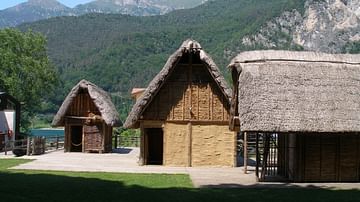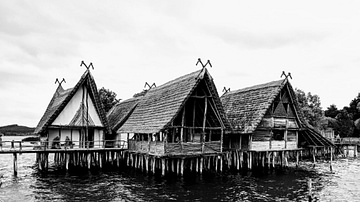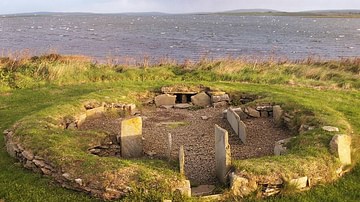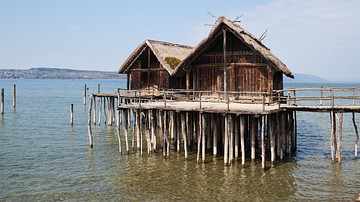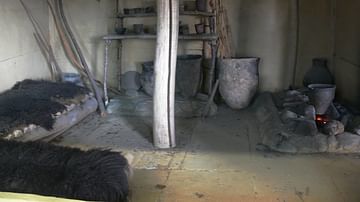Alpine stilt houses are a unique and fascinating aspect of prehistoric architecture in the Alps, which provide valuable insights into the lives and culture of the ancient communities. The houses were built by prehistoric communities living in the alpine regions of Austria, Germany, Italy, and Switzerland.

19 of these archaeological sites are in Italy, some of them in Lombardy, between the provinces of Brescia, Varese, Mantua, and Cremona. The structures in Varese are the oldest known pile dwellings, dating back to the beginning of the Neolithic or New Stone Age. In Northern Italy, the earliest known pile-dwelling sites date back to the end of the 6th millennium BCE, while in regions north of the Alps, the oldest sites date back to 4300 BCE. These settlements continued until around 800 BCE. The sites span a wide range of economic development, from early farming societies to more advanced metalworking cultures.
Exploration & UNESCO World Heritage Status
Exploration of prehistoric sites located around the Alps in lakes and bogs began more than 150 years ago. In 2004, Switzerland proposed an international UNESCO world heritage nomination. In 2011, the prehistoric pile dwellings around the Alps were added to the UNESCO World Heritage Sites list in recognition of their historical, cultural, and environmental significance. Austria, France, Germany, Italy, Slovenia, and Switzerland collaborated to obtain the prestigious label for a hidden cultural heritage of immense global value.
The inclusion of the stilt houses on the list is an acknowledgment of their importance as a reminder of the long history of human habitation in the Alps, and their value as a reminder of the resourcefulness of the people who lived there. The stilt houses demonstrate how people adapted to the harsh conditions of the alpine climate and also illustrate the importance of the lakes and rivers of the region to the local economy.
Construction
The good preservation of the architectural wooden elements in houses is one of the characteristic features of pile dwelling sites. They show how skilled and competent people were in working with wood. The poles were planted deep in the soft, water-saturated ground, where they were more likely to be preserved. They constituted the supporting elements that held up the roof or formed part of the walls. Sometimes they were part of other types of structures, such as walkways, bridges, palisades, fish traps, or similar structures. To understand the function of each individual pole, it is essential to identify the wood species and define the temporal sequence through the growth rings of trees (dendrochronology). In this way, it is possible to identify structures that are contemporary with each other. Other architectural elements that were also constructed from wood include doors, gates, shingles (wooden tiles), trunks for blockbau constructions, planks, and crosspieces. Each structural element was usually made of wood whose technological properties were particularly suitable for that specific type of use.

The construction of the stilt houses around the Alps was a highly innovative solution to the challenges posed by the alpine environment. The use of wooden stilts as the foundation of the houses allowed for protection from flooding and provided access to the cool temperatures of the shallow waters of the lakes and rivers. Additionally, elevating the houses above the ground provided insulation from the harsh winter climate.
The most common type of stilt house was constructed from split logs of triangular shape driven into the ground. This type of construction was not only efficient but also allowed the houses to blend seamlessly into the natural environment. The walls of the houses were built using a combination of stone and wood, and the roof was made of turf or thatch. This combination of materials helped to insulate the houses and also provided a natural camouflage.
The buildings were typically between one and three stories high and could range from small single-room dwellings to large structures with multiple rooms. This allowed for flexibility in the use of the houses. In some cases, they served as residential dwellings, while in others they were used as storage facilities or workshops, making them an important part of the local economy. The innovative construction techniques and materials used in the building of the stilt houses allowed them to withstand the test of time, and many of them have been preserved to this day.
Significance
The people who lived in the region of the Swiss Alps around Lake Zurich and Lake Constance in prehistoric times were known as the Lake Dwellers. The Lake Dwellers were a Neolithic culture, and their settlements provide insight into their daily life. The artifacts from the stilt houses show significant cultural diversity and cover the period from 5000 to 500 BCE. Currently, scholars are able to identify more than 30 distinct cultural groups associated with stilt house sites. As a result, interactions between the cultural traditions of central and southeastern Europe, western Europe, and the Mediterranean area can be studied and described, even through the Alps.
Many valuable artifacts have been discovered at these sites, including combs made of bone and amber, weaving tools, farming equipment, votive statues, and hunting implements. These findings have helped to create a detailed picture of the environments of Europe's first agricultural societies and have provided valuable information on agriculture, animal husbandry, and the development of metallurgy over a period of more than 4,000 years, from the Neolithic to the Bronze Age.

Among the artifacts are not only ceramic fragments, stone axes, and animal bones, which are virtually indestructible, but also organic remains that can be preserved for a long time when submerged in lake bottoms or in the permanently moist soil of marshy areas. In the absence of oxygen, the microorganisms that cause decomposition cannot survive, which explains their incredibly good preservation. Stilt house sites are famous for yielding the oldest fabrics in Europe. Wooden containers, fishing nets, and intact tools provide a diverse and particularly vivid view of daily life in this distant past.
Life of Lake Dwellers
In the pile-dwelling communities, agriculture and animal husbandry were the primary sources of food. Cattle, pigs, sheep, and goats were raised for their meat, bones, tendons, and skin. Milk was also consumed or processed. Moreover, wear on the bones of these animals indicates that they were also used as a labor force. The main crops grown included various types of cereals, legumes, and plants that produced oil and fiber. During the Neolithic period, barley, spelt, and emmer were cultivated and were likely used for cooking and beer production. Peas, opium poppies, and flax were also grown, and spelt, millet, beans, and lentils were added to the menu in the Bronze Age (circa 2000 BC). Grain, cereal processing residues, and food remains found in ceramic containers suggest the consumption of various types of stew, porridge, and possibly baked goods. Hunting and gathering continued to be an important source of food for these communities. Wild fruits, berries, and nuts were collected as evidenced by kernels, seeds, and shells.
Evidence of fishing practices, including fishing equipment, boats, paddles, and fish, have been found in almost all pile-dwelling sites from the Neolithic to the Bronze Age. Catfish, pike, perch, whitefish, trout, char, bleak, rudd, tench, carp, bleak, and bream were caught using nets, lines, harpoons, and traps, but fragile fish skeletons rarely survive, so it is difficult to determine the exact amount of fish that was consumed. The presence of eggs from fish parasites in human feces suggests that the fish was not well cooked, and this led to visible consequences for the health of the pile dwellers.
We know a lot about how the inhabitants of pile-dwelling sites lived. On the other hand, very little is known about how and where they buried their dead. Despite the absence of tombs, many indications of disease and death have been found in the settlements. Feces, as mentioned above, are a particularly useful source of information. Another particular type of object is pieces of birch tar with dental impressions, which have been interpreted as the first type of chewing gum. The dental impressions have also allowed specialists to determine the age and condition of the teeth. Since birch tar has anti-inflammatory properties, we can assume that it was not chewed by people just for fun. According to another theory, these pieces were chewed to soften the material that could then be used to model a handle for the tools. To make an axe, for example, the soft birch tar could be used to secure the flint blades in the groove prepared in a wooden handle. Human bones are rare to find, and the reason why they are sometimes found in settlements is usually not clear.
Materials Used by the Lake Dwellers
As the name suggests, during the Stone Age, stone was a primary material for tool-making. It was also still used in combination with the metals discovered in the Copper and Bronze Ages. Flint was mined and chipped into sharp-edged fragments, which were used to make blades, arrowheads, scrapers, gouges, and other tools that could be fitted into bone or horn handles. Different types of rocks were used for making grindstones, hammers, axes, and decorative objects, using various techniques such as chipping, sawing, smoothing, hammering, and drilling. By tracing the source of different types of rock, researchers can reconstruct the network of contacts and exchanges across Europe, which evolved over time.
Pottery production in central Europe began around 6000 BCE. Clay was extracted from nearby and mixed with tempering agents such as crushed stone, grog, straw, manure, crushed shells, or bones to increase its resistance to cracking and reduce shrinkage during drying. Smaller containers were made by flattening clay dough, while larger and more elaborate containers were made using the coiling technique. Pots could be made smooth and polished with a smoothed stone, and various decorative patterns could be imprinted or engraved using fingers, wooden or bone tools. Different shapes, types of decoration, and styles of pottery are often characteristic of a particular period or geographical area, and pots could be fired in an open-fire hearth or in a pit, which allowed the potter to better control the temperature and oxygen supply during firing.
Wooden wheels and axles were remarkable finds from stilt house sites and among the earliest cart remains found in the world. Dating back to the Neolithic period, the wheels were made of boards held together by wooden joinery and were technologically advanced. Single-log dugout boats, carved from a single tree trunk, were equally remarkable. Wood was also used to make handles, rods, and other parts of tools, and the selection of wood was important because its technological properties had to be suitable for the construction of architectural parts, tools, or containers. The most widely used wood species were oak, pine, ash, alder, willow, poplar, lime, birch, etc. Moreover, it has been highlighted that the intensive exploitation of forests for wood had a lasting impact on the forest areas around lake settlements.
Bone and horn were used to make durable and flexible objects, such as tools for woodworking, knives, and axes, but also needles, awls, and other tools for working leather and fabrics. Horn was used to make ax handles, as its elasticity could absorb the shock when hitting the wood and prevent the tool from being damaged. Ornamental objects such as combs, pins, pendants, and beads could also be made from animal bones, horns, or teeth. A special object found in lake settlements is the "horn cup" made from the base of the antler.
Fabrics, baskets, and bags, but also hats, shoes, capes, and belts were among the textile artifacts found in stilt house sites, along with different types of thread and rope. Thin fishing nets were made, as were sturdy ropes, which were mainly used in wooden constructions. Lime, oak bark, birch bark, and linen were the main materials worked. Tools such as spindles, spindle whorls, loom weights, combs, and separators were all used in processing.
Copper was first used as a raw material in the Alpine region at the beginning of the 4th millennium BCE. Due to its frequent use, the late Neolithic period is also known as the Copper Age. Initially, copper objects were probably imported from central and eastern Europe, where the extraction and processing of copper ore were already well developed. However, it was not long before finished metal objects and tools, such as crucibles, appeared in pile-dwelling sites, indicating that the new raw material was being processed on site. Compared to the techniques of processing stone, clay, wood, bone, or horn, copper metallurgy represented a completely new technology. By the end of the 3rd millennium BCE, the first objects made of bronze, an alloy of copper and tin, appeared. This marked the beginning of a new period, known as the Bronze Age. The addition of tin to copper made the melting process easier, as the alloy had a lower melting point. This allowed artisans to see new possibilities and create new types of tools, as bronze is actually more resistant than copper.
Alpine Stilt Houses in Lombardy today
For a trip over 4,000 years of history, it is worth visiting Isolino Virginia, a small peaceful oasis in Lake Varese, Lombardy. It was donated to the Municipality of Varese in 1962 by Marquess Gian Felice Ponti and has been one of the most famous prehistoric sites in Europe since its discovery in 1863. The island is the oldest prehistoric pile-dwelling settlement in the Alpine arch and the perfect example of how the local population, in response to changes in the waters of the lake, had to repeatedly adapt or move their homes by occupying different parts of the island and using different materials. The island, part of the municipality of Biandronno, houses an interesting archaeological museum with reconstructions of Neolithic dwellings and displays of artifacts found during excavations. This settlement, occupied by humans for over 4,000 years, is of extreme importance for the understanding of northern trans-Alpine and European prehistory.
The site can be visited by following the outdoor educational trail or by entering the small Prehistoric Museum. A welcome video greets the visitor and as they continue along the path, they can observe a full-scale reconstructed pile dwelling created using experimental archaeology methods and furnished with some pieces found on the islet itself.

In the same region, Lombardy, the largest prehistoric pile-dwelling settlement was discovered. In the late 19th century, during the peat extraction in the small Polada basin near Lonato del Garda, the most famous pile-dwelling was discovered by G. Rambotti. This discovery gave its name to the culture that characterizes the Early Bronze Age of the Garda region, known as the Polada Culture. Similar pile-dwellings were also found in other nearby basins, such as Cattaragna in Lonato.
Today, numerous pile-dwelling settlements are submerged along the shores of Lake Garda, including San Sivino-Gabbiano in Manerba (listed site), Porto di Moniga, La Cà, and West Garda in Padenghe, Corno di Sotto in Desenzano, Lugana Vecchia (listed site), Porto Galeazzi, San Francesco and La Maraschina in Sirmione. The Desenzano Museum exhibits a selection of materials from these pile-dwellings, except for the findings from San Sivino, which are housed in the Valtenesi Archaeological Civic Museum in Manerba del Garda. A section of the Antiquarium of the Catullo Grottoes in Sirmione is dedicated to the pile-dwellings found along the Sirmione peninsula.



